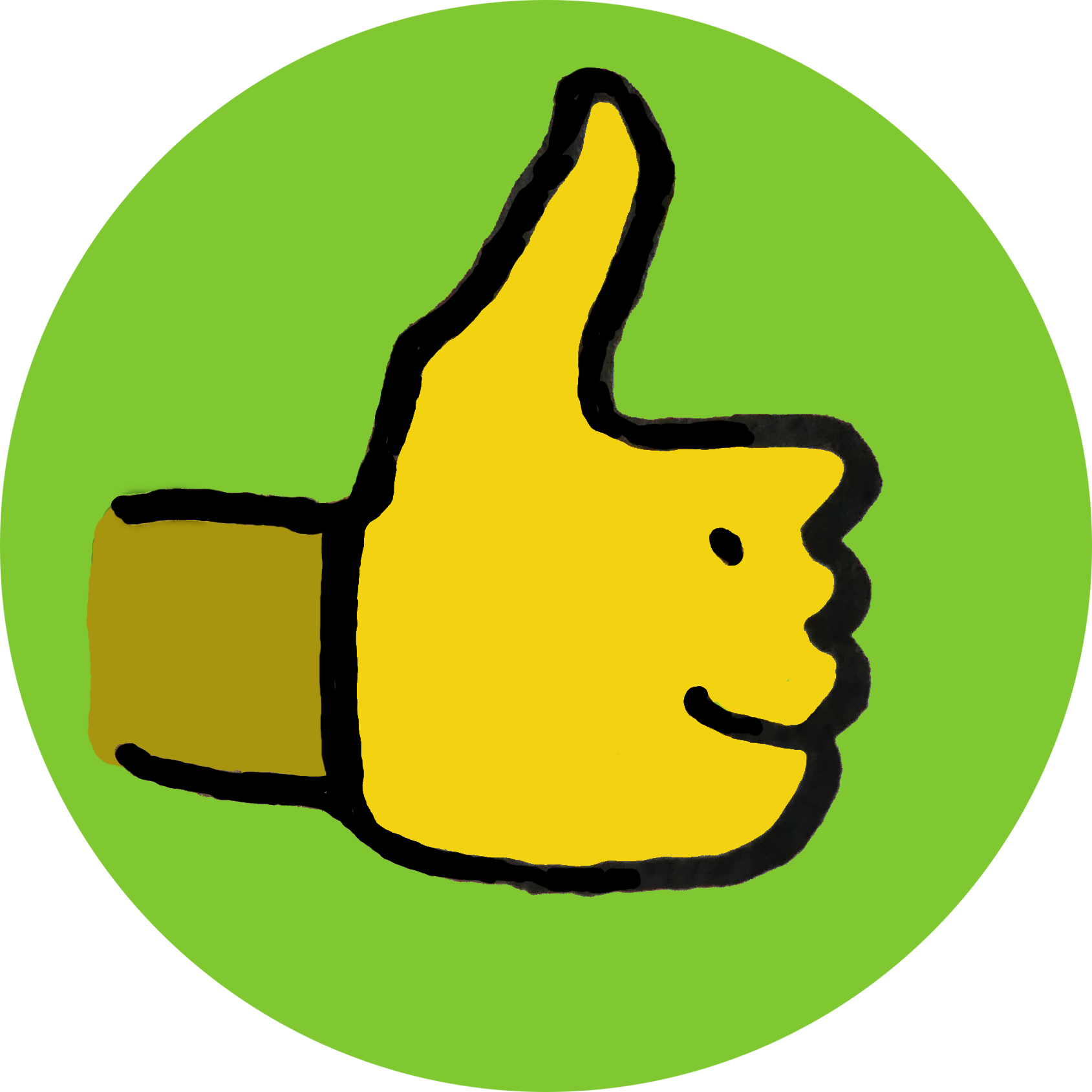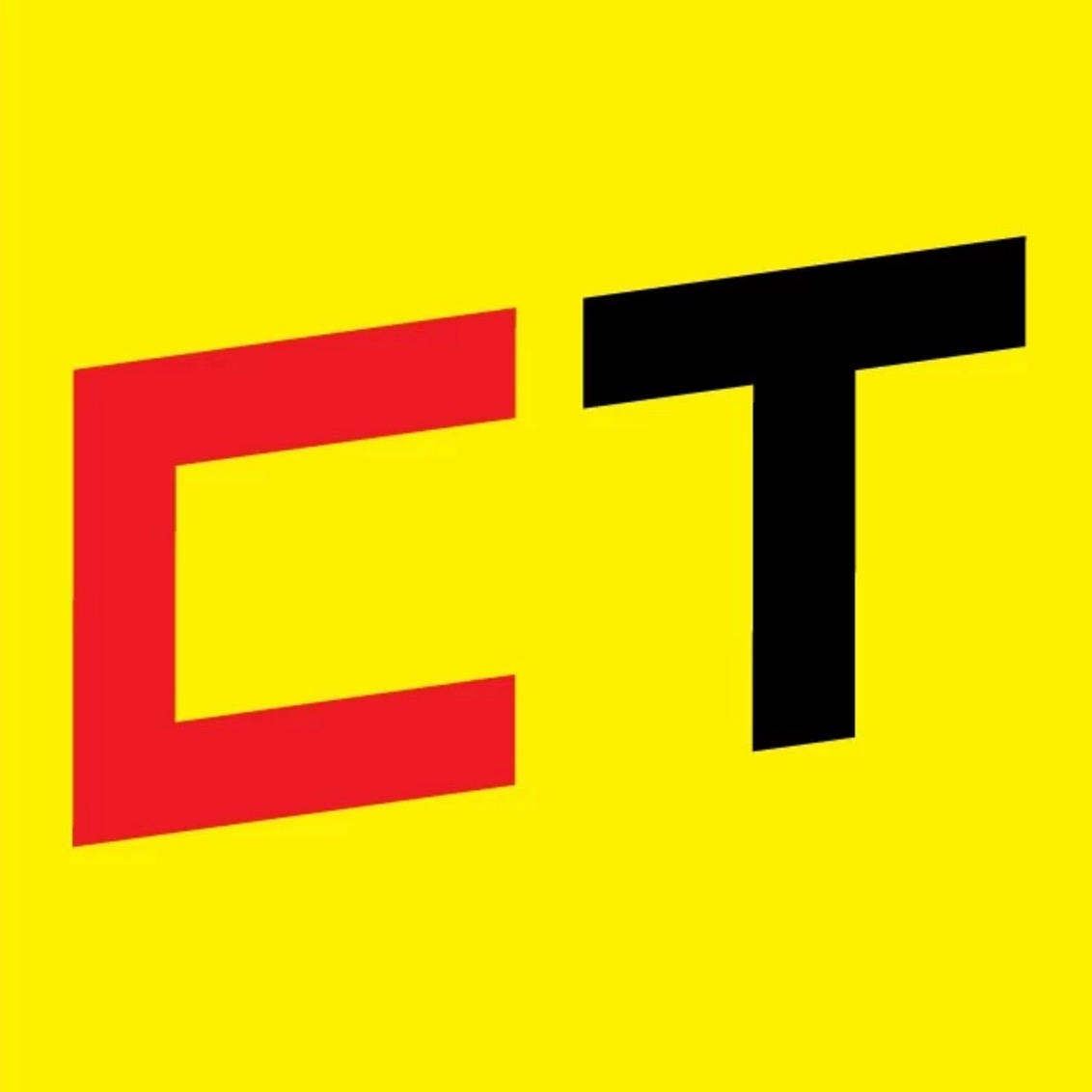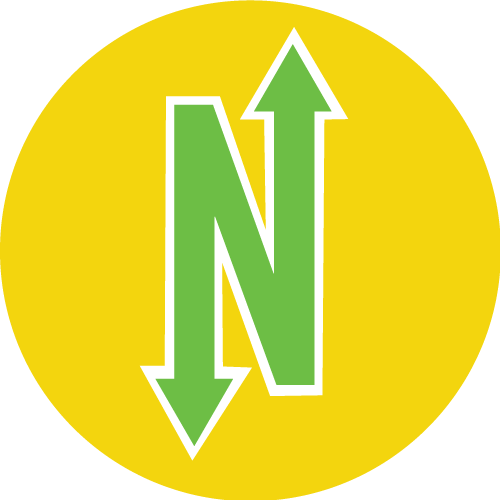18 January 2026
Recomendo Deals / Zip Air / 35 simple health tips
Recomendo - issue #497
Recomendo Deals
We launched a free daily email newsletter called Recomendo Deals that alerts you when products we’ve previously recommended in Recomendo and Cool Tools drop to unusually low prices. Here’s how it works: Every day, the system checks thousands of products we’ve recommended over the years against Keepa, a service that tracks Amazon price history. When a product falls 20% or more below its 90-day average price, or hits an all-time low, it surfaces as a deal. These aren’t random products — they’re things we’ve already vetted and recommended. I’ve already purchased a few items myself. It literally takes 20 seconds to scan the 5 to 10 deals that show up each day, and most days there’s nothing I need. But occasionally, something I’ve had my eye on drops to a great price. Give it a try by subscribing here. — MF
Bargain flights to Japan
By far the best bargain flights to Japan are through a Japan Airlines subsidiary called Zip Air. Our family used it going both ways to Tokyo this holiday and I can highly recommend them. All routes begin or terminate in Tokyo, flying from hub cities in Asia, such as Singapore, Hong Kong, and from select cities in the US. Prices vary widely during the year, but on some weeks this coming spring an economy ROUND TRIP flight from San Francisco to Tokyo is only $283!!!! Of course, they charge for everything from meals, water, blankets, and luggage. But we can manage. And their “lie full flat” seats (business class) are less than $2,000, but also without blankets, pillows, or service. We tried both the economy and full flat seats, and both are worth the small hassles for the ridiculous cheap prices. — KK
35 simple health tips
This article gathers 35 simple, research-backed practices from sleep specialists, sex therapists, psychologists, nutrition scientists and more, each offering one small habit they personally rely on to support everyday well-being. The whole list is great, and I especially love the reflection on “soft fascination” — turning to simple, almost meditative tasks when there are too many mental tabs open, and letting answers rise on their own. For me, washing dishes is always a meditative reset that clears out mental clutter and restores a sense of spaciousness. — CD
Understanding Old English
What we now call the English language has been rapidly changing for over a thousand years. The best way to experience this evolution is to watch this video by Simon Roper where the same passage is recited in proto-English, and then repeated in newer versions of Old English every hundred years, until you reach modern English. The game is to see when you begin to understand it. For me it was around 1600 in part. This gimmick, more than any other, gave me an appreciation of what ancestral versions of English were like. — KK
Dream school newsletter
Every night I have multiple, vivid dream adventures, and for the past five years I’ve been writing them down and treating them as a parallel stream of consciousness for self‑reflection, healing, and guidance. The dream teacher who’s helped me the most is author Robert Moss, whose free Substack is a living archive of shamanic “active dreaming” prompts, personal stories, and techniques that make it easy to develop a co‑creative relationship with your dreams. If you’re at all interested in understanding your dream self on a deeper level, I highly recommend subscribing to his newsletter. Two great starting pieces are “Nine Keys to Understanding Your Dreams” and “The Only Dream Expert is You.” — CD
Satisfying squish
A relative with ADHD brought a NeeDoh to a family gathering, and I couldn’t put it down. Like me, she uses fidgets to focus, and this one is perfect — a soft, stretchy ball filled with a viscous dough-like substance inside a silicone skin. You squeeze, squish, and stretch it, and it slowly oozes back to its original shape. The resistance is deeply satisfying. Her tips: keep it in the fridge to make it harder(and more fun) to squeeze, and when the silicone skin gets grungy, wash it with soap and water, then rub cornstarch over it — good as new. NeeDoh comes in various shapes (balls, cubes, figures) and costs around $5-10. Great for desks, meetings, or anywhere you need to keep restless hands busy. — MF
Sign up here to get Recomendo a week early in your inbox.
01/18/2616 January 2026
Book Freak #193: How to Decide
Simple Tools for Making Better Choices
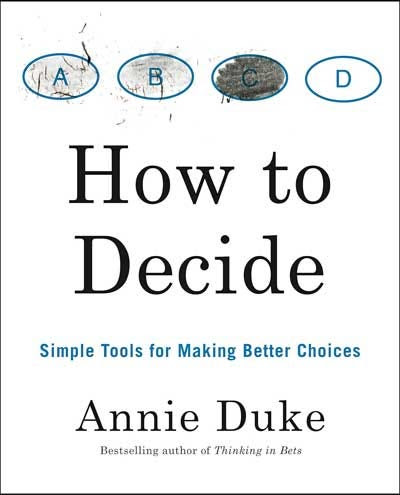
Drawing from her experience as a professional poker player and decision strategist, How to Decide offers a practical toolkit for making better choices by separating decision quality from outcome quality — teaching you to think in probabilities, overcome cognitive biases, and stop second-guessing yourself.
Core Principles
Stop “Resulting”
“Resulting” is Duke’s term for judging a decision’s quality by its outcome. A good decision can lead to a bad outcome (and vice versa) because of factors outside your control. When you overfit decision quality to outcome quality, you risk repeating errors that preceded a lucky good outcome and avoiding good decisions that didn’t work out due to bad luck.
The Only-Option Test
When stuck between choices, ask yourself: “If this were the only option I had, would I be happy with it?” If you’d be happy with either option, the decision is actually easy — flip a coin. This test reveals that “hard” decisions are often easy because both options are acceptable.
Think in Probabilities
Instead of binary thinking (”this will work” or “this won’t”), assign percentage likelihoods to outcomes. Every decision involves the Three P’s: Preferences (what you value), Payoffs (potential gains and losses), and Probabilities (how likely each outcome is). This framework forces you to acknowledge uncertainty and consider alternatives.
Get the Outside View
Solicit feedback from others before making decisions, but do it right: let them answer first before expressing your own opinion to avoid contaminating their views. Ask them to argue against your position. The goal is getting genuine perspectives, not confirmation of what you already believe.
Try It Now
- Think of a decision you’re currently facing with two or more options.
- Apply the Only-Option Test to each choice: “If this were my only option, would I be happy with it?”
- For each option, list the possible outcomes and assign a probability (percentage) to each.
- Apply the Happiness Test: “How much will this affect my happiness in a week? A month? A year?” If not much, spend less time deciding.
- If the options still seem close, flip a coin — and notice how you feel when it lands. Your reaction reveals your true preference.
Quote
“The quality of the outcome casts a shadow over our ability to see the quality of the decision.”
01/16/2615 January 2026
Cheapest Flight Destinations/Packable Daypacks/Europe Ski Bargains
Nomadico issue #188
The Best Flight Values for 2026
Keeping your variables open is the best way to snag good flight deals and Dollar Flight Club has released data on your best cheap flight bets in 2026 from the USA. Internationally, besides the cities they list in Canada, Mexico, and Central America, you’ll probably find good prices to Madrid, Lisbon, and Medellin. Domestically, the top 5 are Ft. Lauderdale, Orlando, Chicago, Pittsburgh, and Dallas.
World Cup Hotel Price Spikes
Got a friend living in a city that’s hosting World Cup matches? Hotel rates in the USA are up 50 to 100% in some cities around the event, but with so many international travelers skipping USA travel these days, Mexico is seeing price spikes that are in the stratosphere. According to this report, rates are up 405% in Guadalajara, 466% in Monterrey, and in properties not already sold out, 961% in Mexico City.
Best Packable Daypacks
One of the most useful travel items you can buy yourself or someone else is a backpack holding 20 liters or so that scrunches down into a little pouch for packing. Once you get to where you’re going, it’s great for sightseeing, hiking, or grocery shopping. I’ve used many of them over two decades, but the available ones I’d give the highest recommendation to for important features (like a water bottle holder) and durability are from Osprey, Eddie Bauer, and this Chicobag one made from recycled plastic bottles.
European Ski Bargains
Each year I update my blog post on the cheapest places to ski in Europe and even with a declining greenback, these places will still cost you a fraction of the lowest-priced options stateside. I’m heading to one in Slovakia in February that’s €49 per day for 50 kilometers of runs and I highlight others for that price down to €23 per day in locations stretching from Slovenia to Poland to Georgia. Prices off the slopes are great too, usually with better food and drink overall.
A weekly newsletter with four quick bites, edited by Tim Leffel, author of A Better Life for Half the Price and The World’s Cheapest Destinations. See past editions here, where your like-minded friends can subscribe and join you.
01/15/2614 January 2026
What’s in my NOW? — Jeremiah Krage
issue #237
I used to be a Teletubby and a Cyberman. Now I design AI personalities and characters. The link is creating fictional characters that can connect with audiences (and users). We are rapidly moving into a world where we talk to technology—I make those conversations more natural and intuitive.
- Connect with me here: https://www.linkedin.com/in/jeremiahkrage/
- See more about my AI Character work: https://workwith.jeremiahkrage.com/
- A current AI Character-led product I’m helping to design: https://www.vessa.ai/
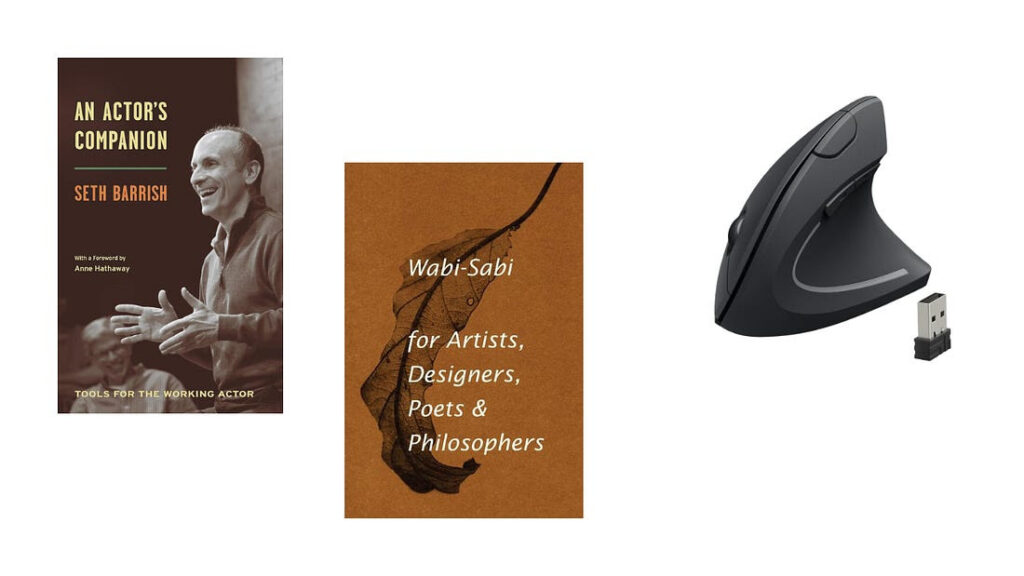
PHYSICAL
- An Actor’s Companion: Tools for the Working Actor – Seth Barrish
Even if you’re not a performer, this is full of actionable approaches to challenging assumptions, getting out of ruts, and breaking up routines so that you bring a fresh creative approach to problems. - Wabi-Sabi for Artists, Designers, Poets & Philosophers – Leonard Koren
If you struggle with perfectionism or have a tendency to overwork ideas, this offers a different perspective. If you’ve ever found yourself deeply frustrated by AI that gets close to what you want, but just keeps missing the mark, you may find the celebration of imperfection and incompleteness is a great antidote. - Anker Vertical Mouse
I was getting a lot of wrist issues using a traditional mouse. This eliminated that completely. It only took about 5 minutes to get used to the new orientation.
DIGITAL
- AI for Humans – YouTube show and podcast making AI practical, accessible, and keep it light-hearted. Hosts are both from the media backgrounds, so this skews towards creative outputs. A quick and fun way to keep on top of the latest developments in and applications of AI. I highly recommend the YouTube version as they share lots of visuals.
- DeepLearning.ai – this is a brilliant resource for upskilling in AI. Founded by the delightful Andrew Ng (Google Brain, Baidu, Stanford Uni.) who teaches many of the courses. If you’re interested in building with AI and have some technical facility, this is a great place to learn more from leaders in the field. Most courses are free (with paid certificates).
INVISIBLE
“Now is the moment to explore these new tools and shape them for the future of storytelling.” — Darren Aronofsky (filmmaker, ‘Pi’ ‘Requiem for a Dream’) talking about AI
01/14/26
13 January 2026
Woody Guthrie / Jane Austen and Virginia Woolf
Issue No. 100
HOW TRAGEDIES OF THE GREAT DEPRESSION INFLUENCED SINGER WOODY GUTHRIE
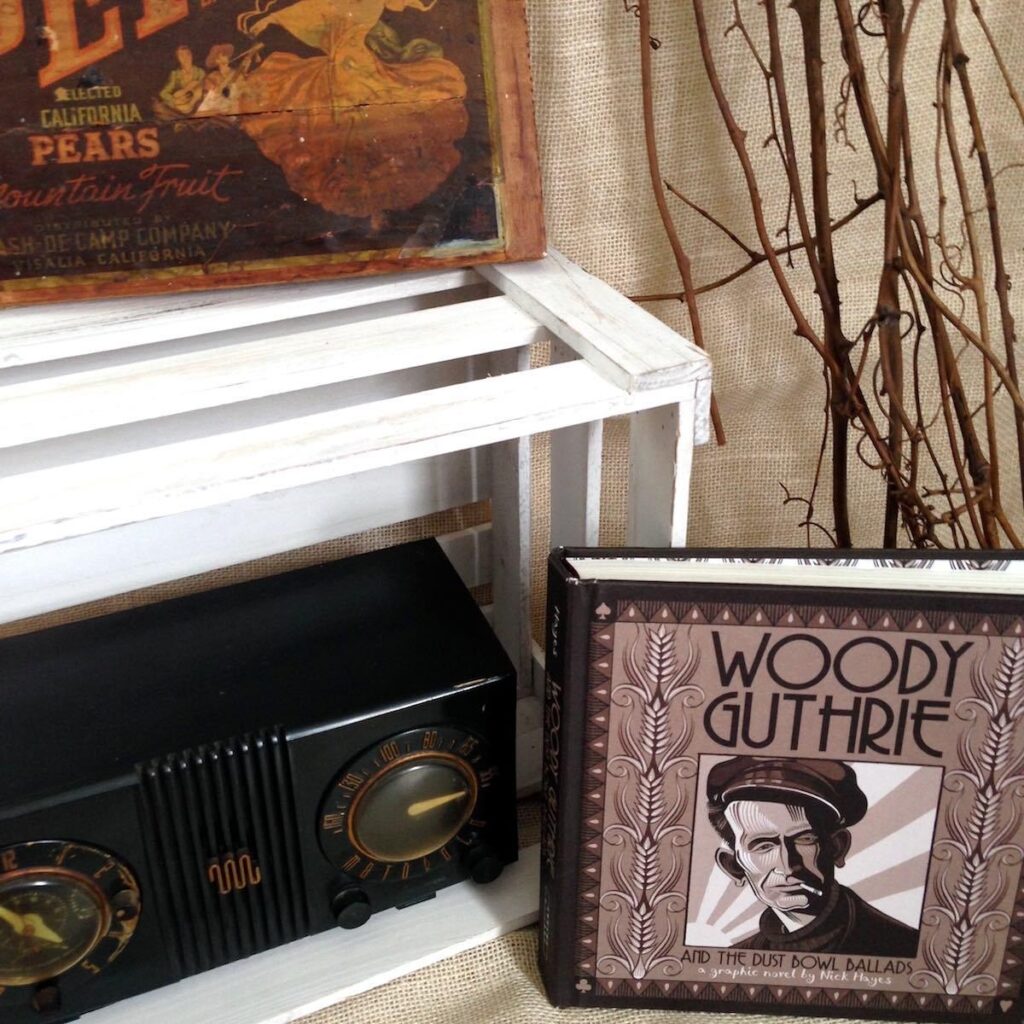
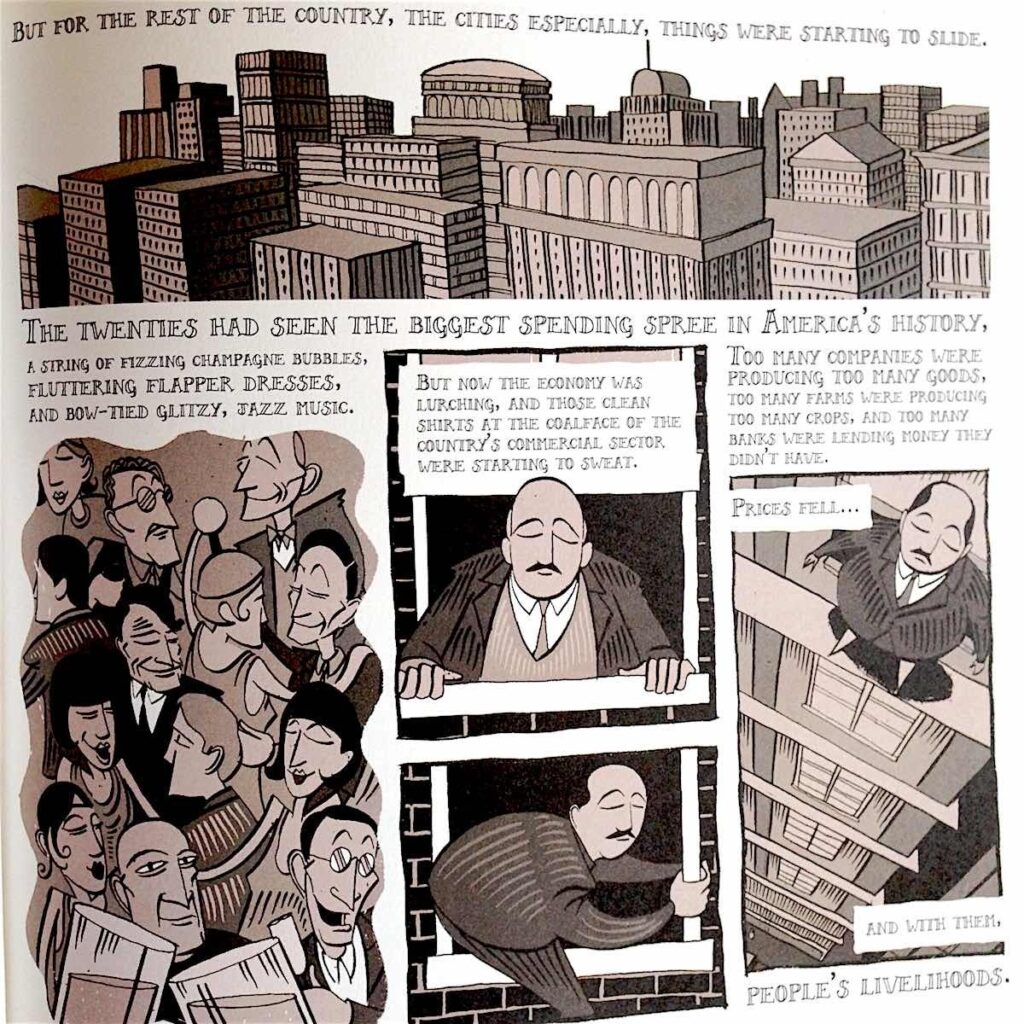
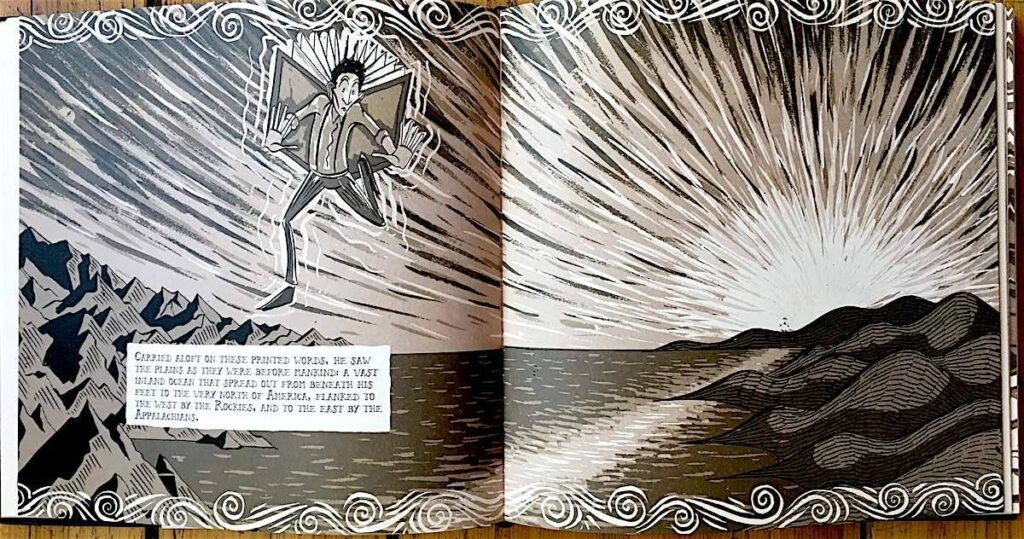
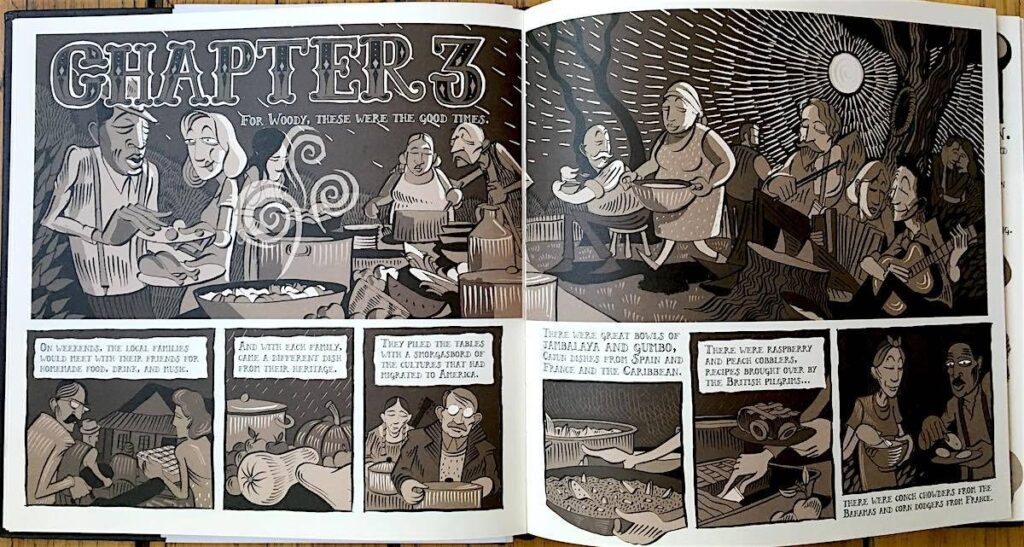


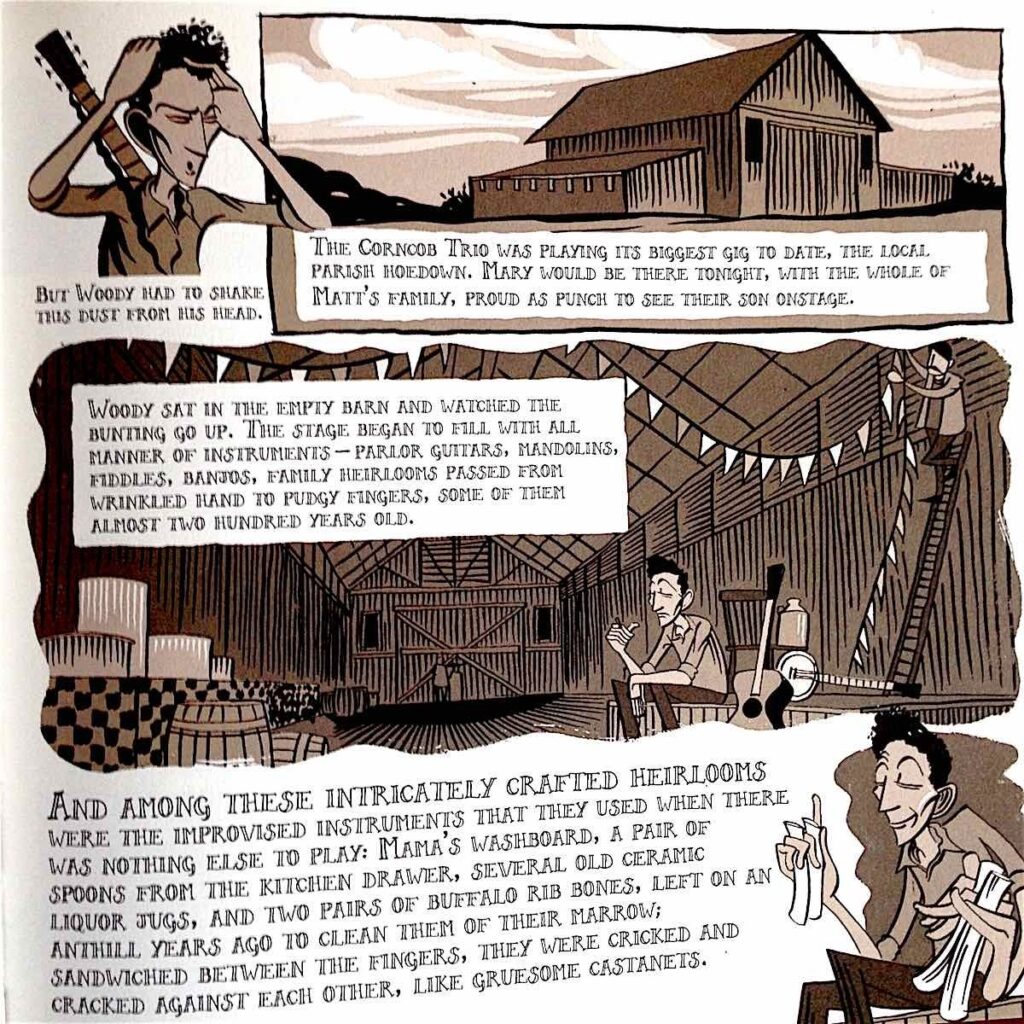

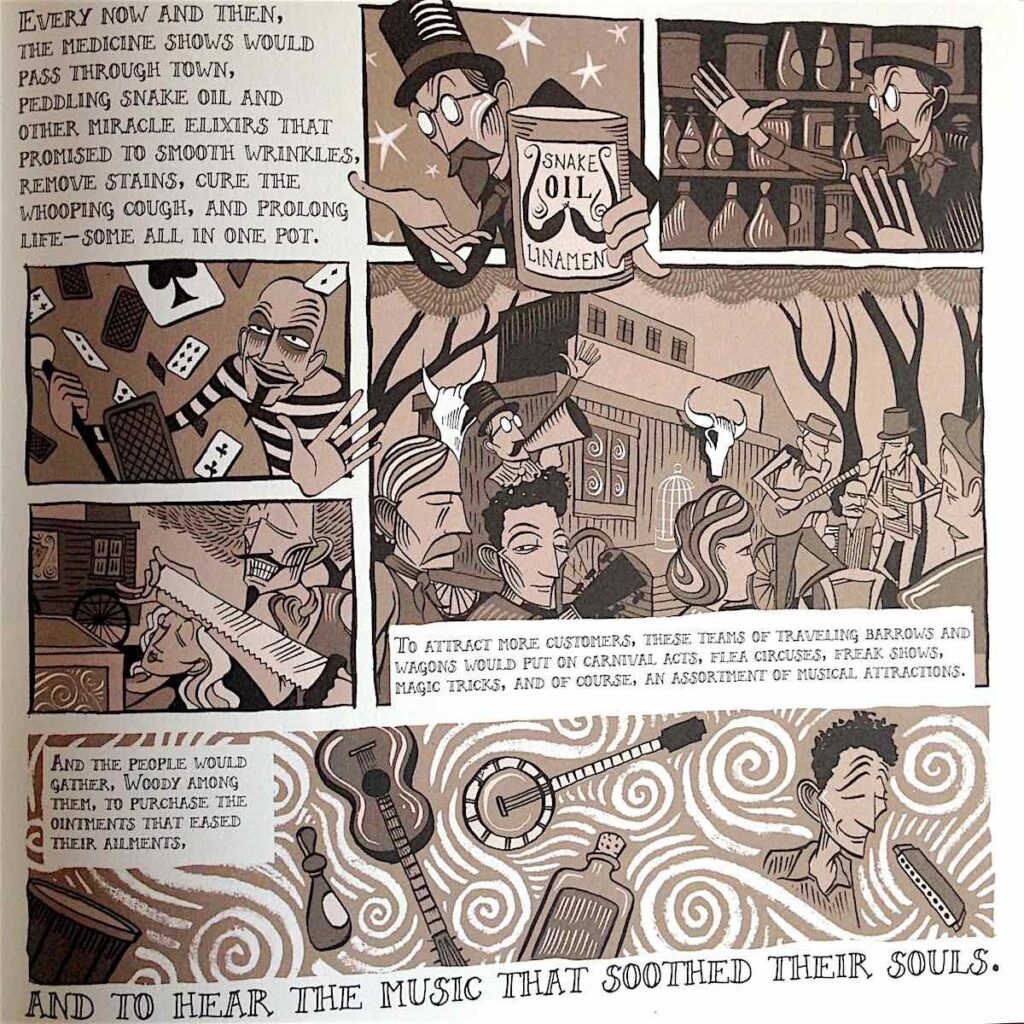
Woody Guthrie and the Dust Bowl Ballads
by Nick Hayes
Harry N. Abrams
16, 272 pages, 8.6 x 8.6 x 1.2 inches
A graphic novel of the life and early career of singer Woody Guthrie, Woody Guthrie and the Dust Bowl Ballads is a sepia and dusty brown, linocut illustrated graphic novel. It begins with harrowing tales of his youth – his mother burning his father with coal oil, resulting in her being shipped off to the Hospital For The Insane, the collapse of his Pampa hometown as the plummeting price of wheat ruined the local and national economy, and Guthrie traveling roads and hopping trains during the Great Depression. His encounters with snake oil salesmen and carnival acts, hobos, and migrant workers, as well as his exposure to the music of Cajuns, Native Americans, Xit cowboys, and Appalachian folksong performances at barn dances ultimately inspire him to take up the fiddle and write original tunes.
Along with Woody’s story, the book provides a powerful backstory on the environmental conditions of the Dust Bowl region, including the displacement of Native Americans through the push of white settlers on native lands, agriculture techniques that resulted in the tearing up of the bluestem grasses to plant wheat, an unprecedented drought, and the glut of wheat causing the exodus of settlers to California. This all brings to life the tragic unraveling of the fragile Dust Bowl ecosystem and brings about the hardscrabble lives and dust-blown landscape that Guthrie integrates into his music. Drifting through America with his guitar and knocking on doors begging for work, he reluctantly stumbles into an uncomfortable fame with a radio show, leading to national recognition. The book ends with the creation of his masterpiece, “This Land Is Your Land”, with the now-redacted communist lyrics included, which became America’s unofficial National Anthem.
Woody Guthrie and the Dust Bowl Ballads is a somber, bittersweet tale of the singer/songwriter, and the harrowing tragedy of the Dust Bowl years. It’s a weighty, handsome book. Lovely, broad-stroked illustrations bring to life the desperate struggle of 1930s midwestern America. – S. Deathrage
LIBRARY OF LUMINARIES LAUNCHES THEIR BITESIZE BIO SERIES WITH JANE AUSTEN AND VIRGINIA WOOLF
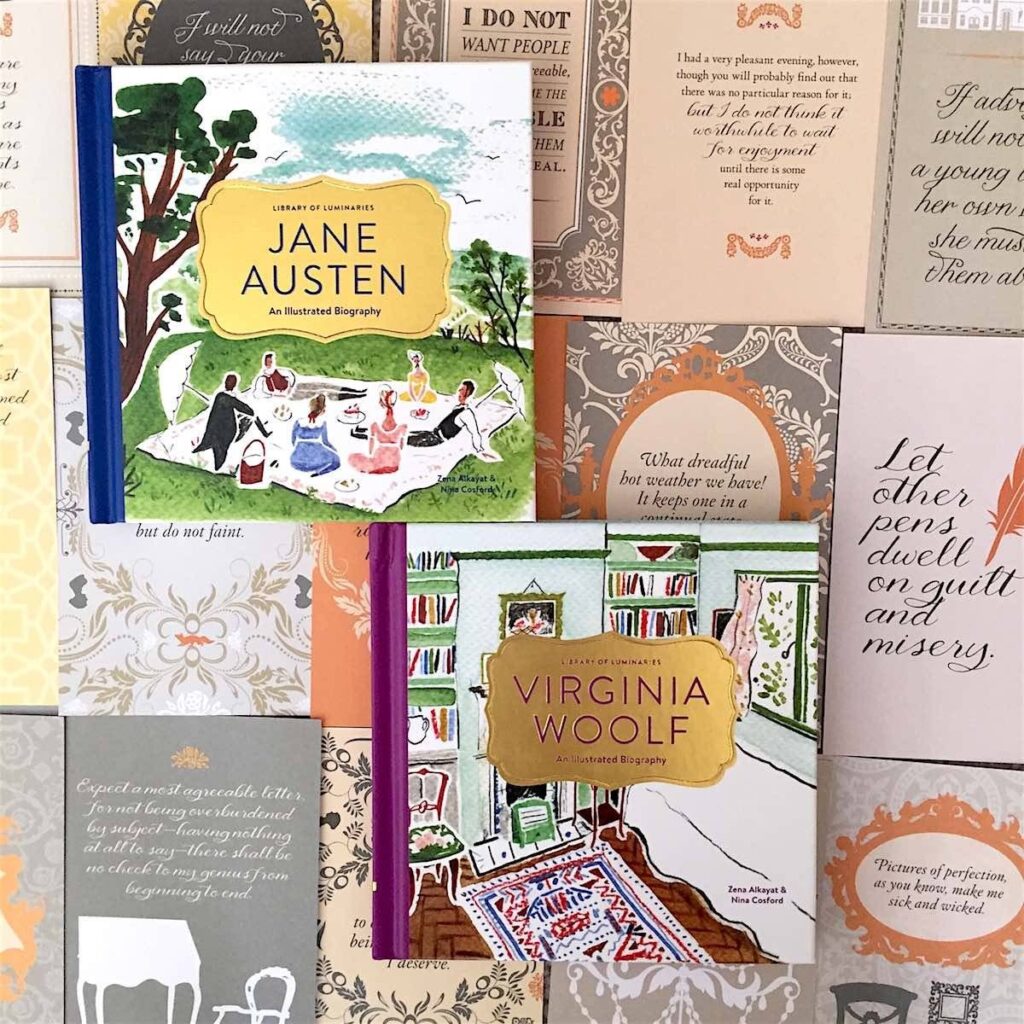
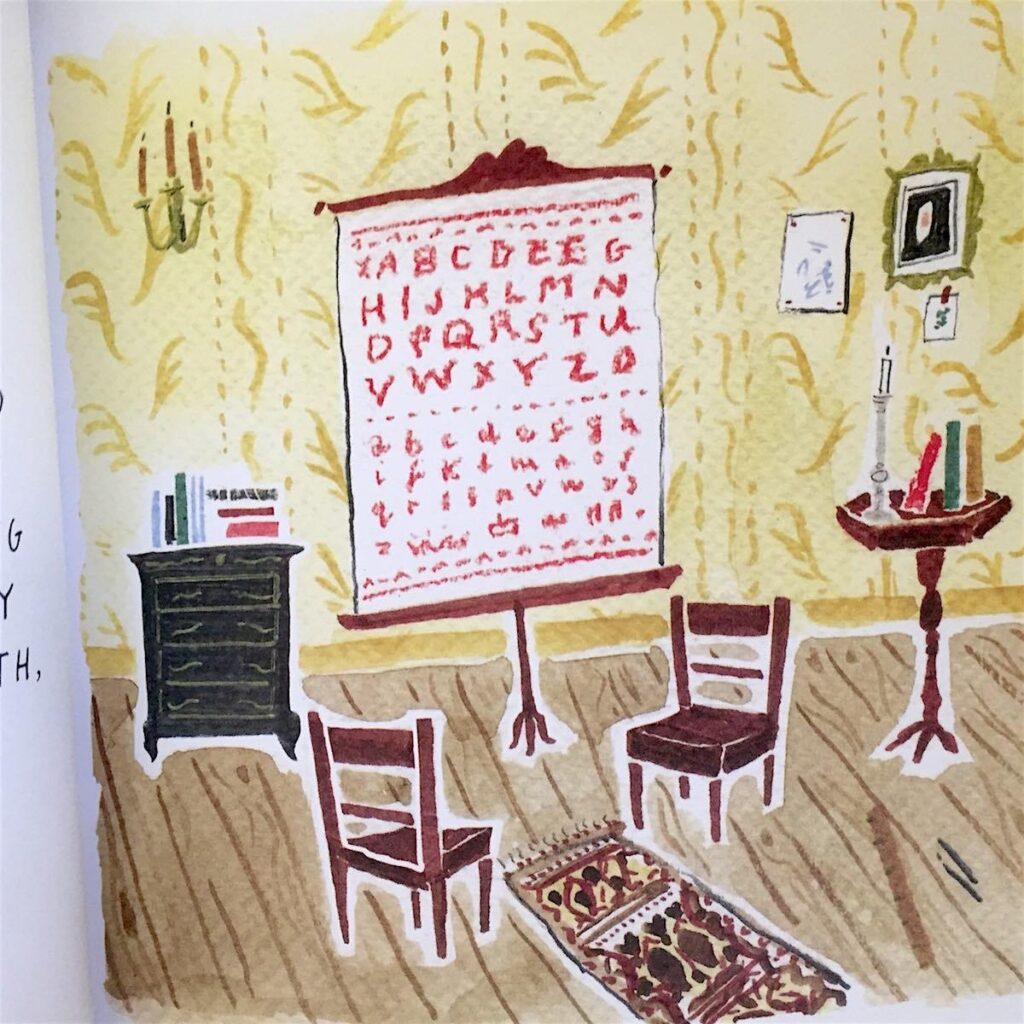
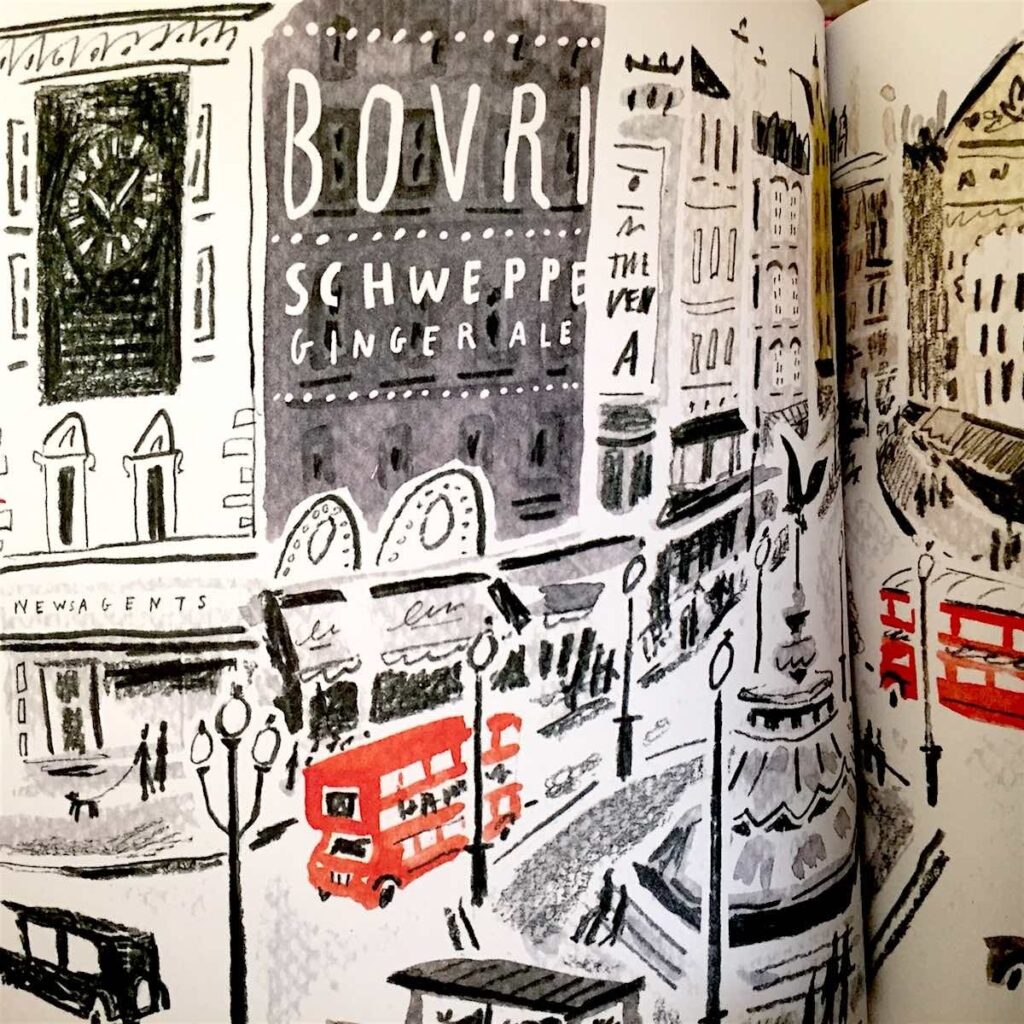
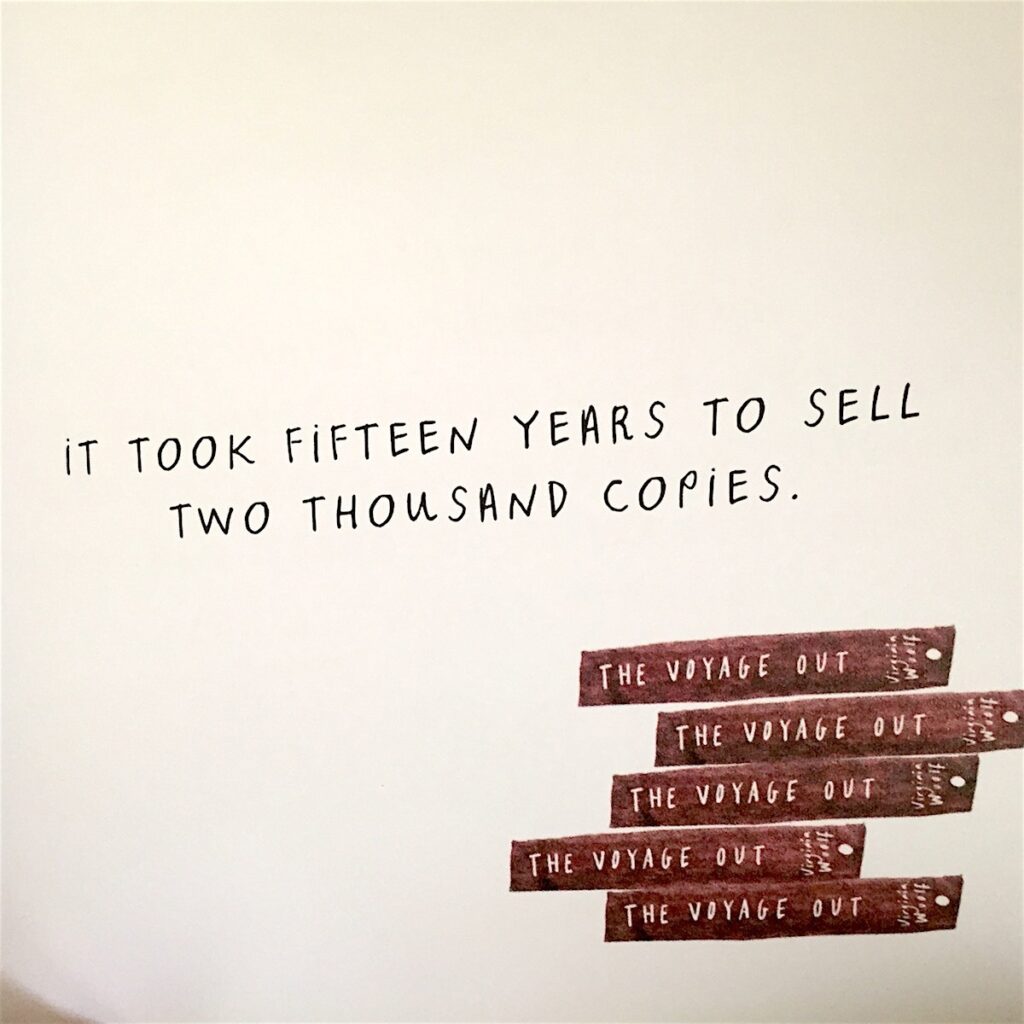
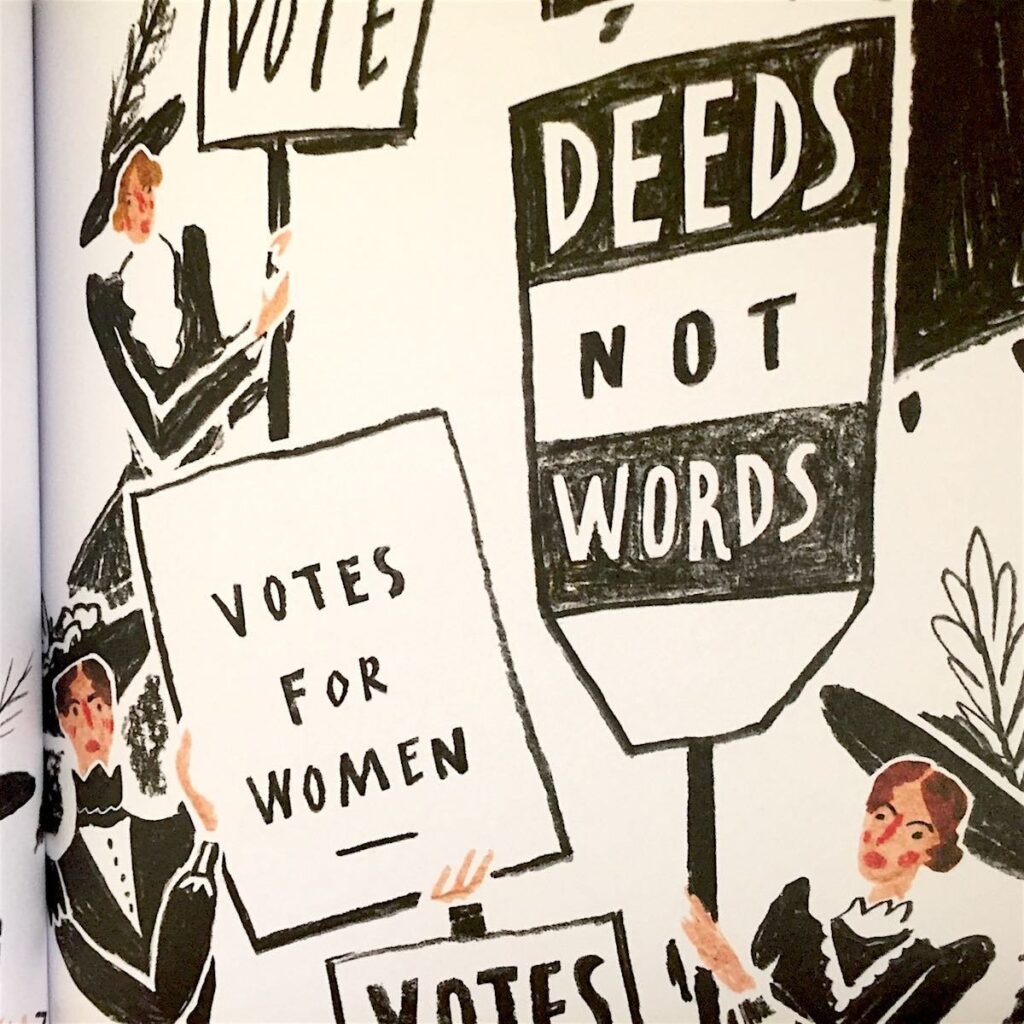
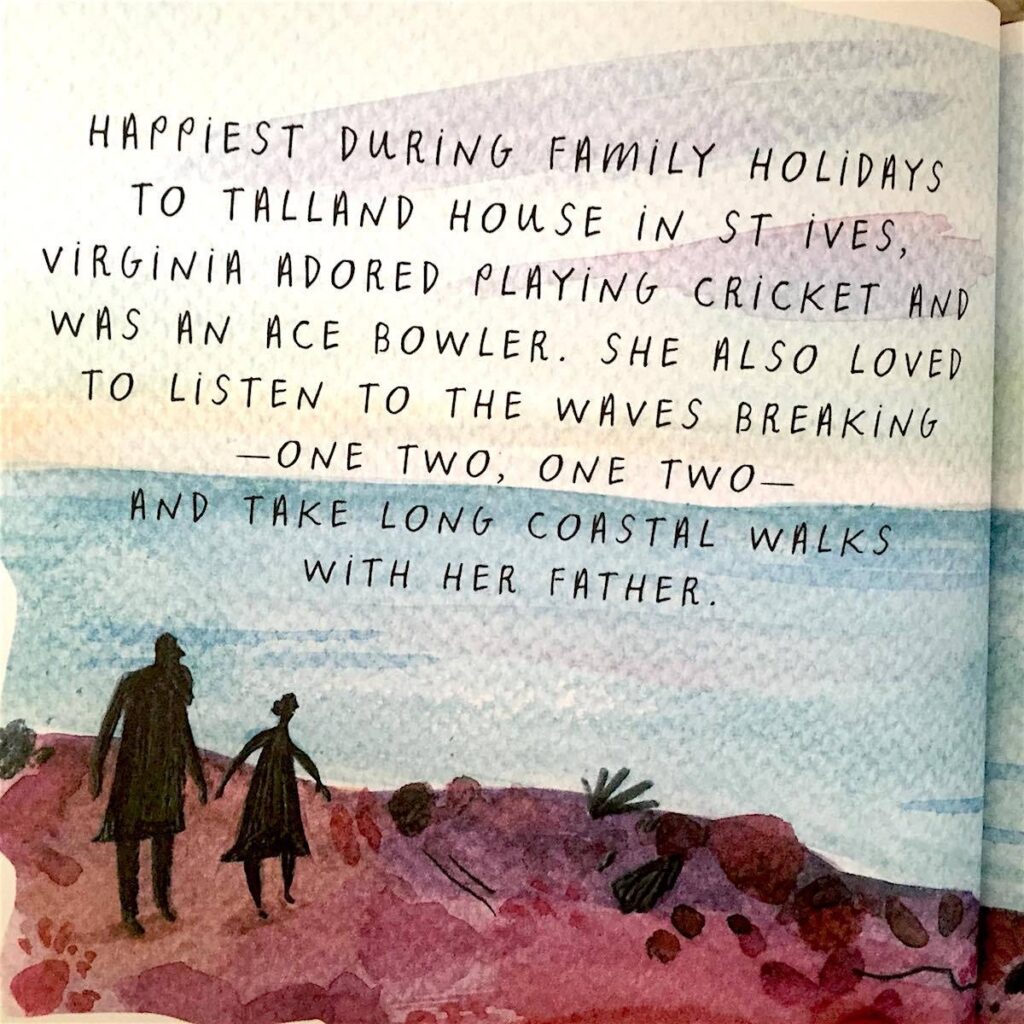
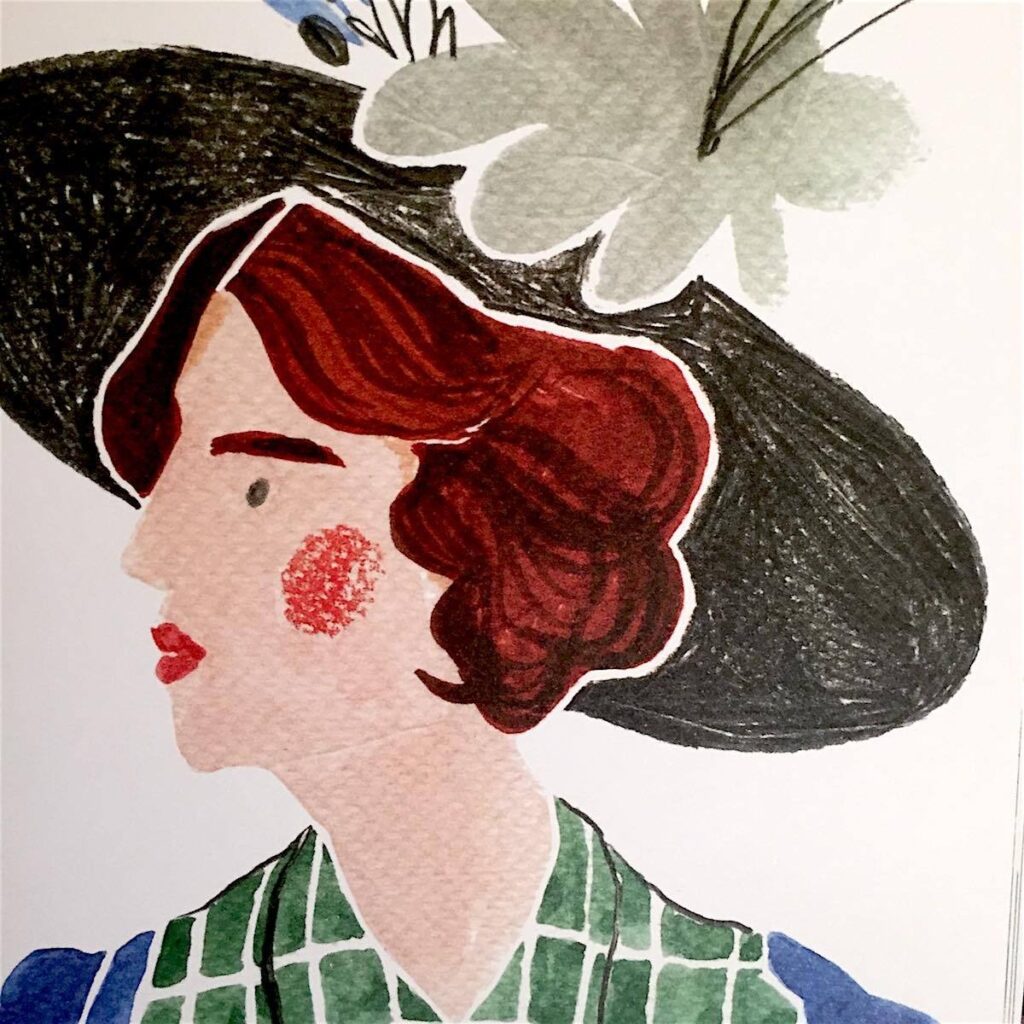



Jane Austen: An Illustrated Biography and
Virginia Woolf: An Illustrated Biography
by Zena Alkayat (author) and Nina Cosford (illustrator)
Chronicle
2016, 128 pages, 6.2 x 6.2 x 0.8 inches
Virgina Woolf:
Jane Austen:
Hand-written text, whimsical illustrations and lots of fun facts are combined into Library of Luminaries’ new series of Illustrated Biographies. The series launches with small, foil-embossed hardcover books about two famous authors – Jane Austen and Virginia Woolf. (The series will release Coco Chanel and Frida Khalo in August.) This collection is an easy way to learn about the lives and careers of classic authors – it’s like Cliff Notes for literature lovers.
Through bits about family histories, friendships, inspirations, career highlights and low points, the reader gets a glimpse into Austen and Woolf’s worlds. I knew some stuff about both authors’ backgrounds, but wow! I still learned a lot! I had no idea that Austen only earned the meager sum of 140 British pounds in royalties for two years’ worth of the sales for Sense and Sensibility. And that once Austen’s identity was made public, the Prince Regent contacted her directly because he was a huge fan of her books. She went on to dedicate Emma to him. I also didn’t know that Woolf loved dogs and had a pet marmoset named “Mitz,” nor did I know that it took 15 years for the book The Voyage Out to sell 2000 copies. We know these women had tragic lives, but they had joys too. I finished these books with a sigh. – Carole Rosner
Books That Belong On Paper first appeared on the web as Wink Books and was edited by Carla Sinclair. Sign up here to get the issues a week early in your inbox.
01/13/2612 January 2026
Game Design
Tools for Possibilities: issue no. 172

Best how-to-make-fun
This is by far the best guide ever written for designing games. All kinds of games, simple and traditional, but of course video games, too. This fat book is packed with practical, comprehensive, imaginative, deep, and broad lessons. Every page contained amazing insights for me. The more I read and re-read, the more important I ranked this work. I now view it as not just about designing games, but one of the best guides for designing anything that demands complex interaction. My 13-year-old son, who, like most 13-year-olds, dreams of designing games, has been devouring its 470 pages, telling me, “You’ve got to read this, Dad!” It’s that kind of book: You begin to imagine your life as a game, and how you might tweak its design. Author Jesse Schell offers 100 “lenses” through which you can view your game, and each one is a useful maxim for any assignment. — KK
- We must be absolutely clear on this point before we can proceed. The game is not the experience. The game enables the experience, but it is not the experience. This is a hard concept for some people to grasp.
- Lens #1: The Lens of Essential ExperienceTo use this lens, you stop thinking about your game and start thinking about the experience of the player. Ask yourself these questions:
- What experience do I want the player to have?
- What is essential to that experience?
- How can my game capture that essence?If there is a big difference between the experience you want to create and the one you are actually creating, your game needs to change: You need to clearly state the essential experience you desire, and find as many ways as possible to instill this essence into your game.
- Let’s review the list of game qualities we have picked out of these various definitions:Q1. Games are entered willfully.
Q2. Games have goals.
Q3. Games have conflict.
Q4. Games have rules.
Q5. Games can be won and lost.
Q6. Games are interactive.
Q7. Games have challenge.
Q8. Games can create their own internal value.
Q9. Games engage players.
Q10. Games are closed, formal systems.
The thing that really seems to bother people about calling puzzles games is that they are not replayable. Once you figure out the best strategy, you can solve the puzzle every time, and it is no longer fun. Games are not usually this way. Most games have enough dynamic elements that each time you play you are confronted again with a new set of problems to solve. Sometimes this is because you have an intelligent human opponent (checkers, chess, backgammon, etc.), and sometimes it is because the game is able to generate lots of different challenges for you, either through ever-advancing goals (setting a new high score record) or through some kind of rich challenge-generation mechanism (solitaire, Rubik’s Cube, Tetris, etc.)
Specifically, that the player puts their mind inside the game world, but that game world really only exists in the mind of the player? This magical situation, which is at the heart of all we care about, is made possible by the game interface, which is where player and game come together. Interface is the infinitely thin membrane that separates white/yang/player and black/yin/game. When the interface fails, the delicate flame of experience that rises from the player/game interaction is suddenly snuffed out. For this reason, it is crucial for us to understand how our game interface works, and to make it as robust, as powerful, and as invisible as we can. - Experiences without feedback are frustrating and confusing. At many crosswalks in the United States, pedestrians can push a button that will make the DON’T WALK sign change to a WALK sign so they can cross the street safely. But it can’t change right away, since that would cause traffic accidents. So the poor pedestrian often has to wait up to a minute to see whether pressing the button had any effect. As a result, you see all kinds of strange button-pressing behavior: some people push the button and hold it for several seconds, others push it several times in a row, just to be safe. And the whole experience is accompanied by a sense of uncertainty — pedestrians can often be seen nervously studying the lights and DON’T WALK sign to see if it is going to change, because they might not have pushed the button correctly.What a delight it was to visit the United Kingdom, and find that in some areas the crosswalk buttons give immediate feedback in the form of an illuminated WAIT sign that comes on when the button has been pushed, and turns off when the WALK period has ended! The addition of some simple feedback turned an experience where a pedestrian feels frustrated into one where they can feel confident and in control.
- For all the grand dreams of interactive storytelling, there are two methods that dominate the world of game design. The first and most dominant in videogames is commonly called the “string of pearls ” or sometimes the “rivers and lakes ” method. It is called this because it can be visually represented like this:The idea is that a completely non-interactive story (the string) is presented in the form of text, a slideshow, or an animated sequence and then the player is given a period of free movement and control (the pearl) with a fixed goal in mind. When the goal is achieved, the player travels down the string via another non-interactive sequence, to the next pearl, etc. In other words, cut scene, game level, cut scene, game level…Many people criticize this method as “not really being interactive, ” but players sure do enjoy it.
- If 10 choices sounds kind of short, and you want to have 20 opportunities for three choices from the beginning to the end of the story, that means you’ll need to write 5,230,176,601 outcomes. These large numbers make any kind of meaningful branching storytelling impossible in our short life spans. And sadly, the main way that most interactive storytellers deal with this perplexing plethora of plotlines is to start fusing outcomes together.
- Problem #3: Multiple Endings DisappointOne thing that interactive storytellers like to fantasize about is how wonderful it is that a story can have multiple endings. After all, this means the player will be able to play again and again with a different experience every time! And like many fantasies,
the reality tends to disappoint. Many games have experimented with having multiple endings to their game story. Almost universally, the player ends up thinking two things when they encounter their first ending in one of these.1. “Is this the real ending? ”
2. “Do I have to play this whole thing again to see another ending?”There are exceptions, of course. Star Wars: Knights of the Old Republic featured a novel type of player choice — did they want to play the game on the “light side ” or “dark side ” of the force — that is, with good or evil goals? Depending on which of the paths you choose, you have different adventures, different quests, and ultimately a different ending. It can be argued that this isn’t really a case of two different endings on the same story, but two completely different stories — so different that they are each equally valid. - Problem #4: Not Enough VerbsThe things that videogame characters spend their time doing are very different than the things that characters in movies and books spend their time doing:
Videogame Verbs: run, shoot, jump, climb, throw, cast, punch, fly
Movie Verbs: talk, ask, negotiate, convince, argue, shout, plead, complain
Videogame characters are severely limited in their ability to do anything that requires something to happen above the neck. Most of what happens in stories is communication, and at the present time, videogames just can’t support that. Game designer Chris Swain has suggested that when technology advances to the point that players can have an intelligent, spoken conversation with computer-controlled game characters, it will have an effect similar to the introduction of talking pictures. Suddenly, a medium that was mostly considered an amusing novelty will quickly become the dominant form of cultural storytelling. Until then, however, the lack of usable verbs in videogames significantly hampers our ability to use games as a storytelling medium. - As the character tries to overcome the obstacles, interesting conflicts tend to arise, particularly when another character has a conflicting goal. This simple pattern leads to very interesting stories because it means the character has to engage in problem-solving (which we find very interesting), because conflicts lead to unpredictable results, in other words, surprises (which we find very interesting), and because the bigger the obstacle, the bigger the potential for dramatic change (which we find very interesting).
Are these ingredients just as useful when creating videogame stories? Absolutely
and maybe even more so. - One focus group I witnessed was trying to determine where the average mom drew the line about what videogames were “too violent ” for their kids. Virtua Fighter was okay, said the moms, Mortal Kombat was not. The difference? Blood. It wasn’t the actions that were involved in the games that bothered them (both games are mostly about kicking your opponent in the face), but rather the graphic bloodshed in Mortal Kombat that is completely absent in Virtua Fighter. They seemed to feel that without bloodshed, it was just a game — just imaginary. But the blood made the game creepily real, and to the moms in the interviews, a game that rewarded bloodshed felt perverse and dangerous.

A large pile of silliness
Silly putty — even the newer varieties like the thinking putty here — has long been sold in small amounts in the classic plastic egg. But this stuff is best enjoyed in bulk. The technical name of this now generic substance is Dow Corning Dilatant Compound 3179. Five pounds of it is…. well, pretty silly. Ten pounds of the stuff is enough to transfer a whole page of comics, or to make a humungous superball, or to lighten up the dour faces in a boardroom after being parcelled out. The surprise for our family has been never ending amusement of watching a huge ball of this compound slowly melt over whatever you set it on, like the blob from outer space. Hand out some at your next birthday party. Don’t ask why. — KK
Once a week we’ll send out a page from Cool Tools: A Catalog of Possibilities. The tools might be outdated or obsolete, and the links to them may or may not work. We present these vintage recommendations as is because the possibilities they inspire are new. Sign up here to get Tools for Possibilities a week early in your inbox.
01/12/26ALL REVIEWS
 01/7/26
01/7/26
What’s in my NOW? — Magnus Ojala
A construction professional based in Sweden, currently working with residential projects. Interested in flow, systems thinking, and practical ways to …
EDITOR'S FAVORITES
COOL TOOLS SHOW PODCAST
WHAT'S IN MY BAG?
14 January 2026

ABOUT COOL TOOLS
Cool Tools is a web site which recommends the best/cheapest tools available. Tools are defined broadly as anything that can be useful. This includes hand tools, machines, books, software, gadgets, websites, maps, and even ideas. All reviews are positive raves written by real users. We don’t bother with negative reviews because our intent is to only offer the best.
One new tool is posted each weekday. Cool Tools does NOT sell anything. The site provides prices and convenient sources for readers to purchase items.
When Amazon.com is listed as a source (which it often is because of its prices and convenience) Cool Tools receives a fractional fee from Amazon if items are purchased at Amazon on that visit. Cool Tools also earns revenue from Google ads, although we have no foreknowledge nor much control of which ads will appear.
We recently posted a short history of Cool Tools which included current stats as of April 2008. This explains both the genesis of this site, and the tools we use to operate it.

